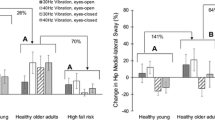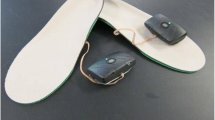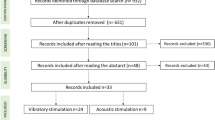Abstract
Introduction
Postural control is of utmost importance for human functioning. Cervical proprioception is crucial for balance control. Therefore, any change to it can lead to balance problems. Previous studies used neck vibration to change cervical proprioception and showed changes in postural control, but it remains unknown which vibration frequency or location causes the most significant effect. Therefore, this study aimed to investigate the effect of different vibration frequencies and locations on postural sway and to serve as future research protocol guidance.
Methods
Seventeen healthy young participants were included in the study. We compared postural sway without vibration to postural sway with six different combinations of vibration frequency (80, 100, and 150 Hz) and location (dorsal neck muscles and sternocleidomastoid). Postural sway was evaluated using a force platform. The mean center of pressure (CoP) displacement, the root mean square (RMS), and the mean velocity in the anteroposterior and mediolateral direction were calculated, as well as the sway area. The aligned rank transform tool and a three-way repeated measures ANOVA were used to identify significant differences in postural sway variables.
Results
Neck vibration caused a significant increase in all postural sway variables (p < 0.001). Neither the vibration frequency (p > 0.34) nor location (p > 0.29) nor the interaction of both (p > 0.30) influenced the magnitude of the change in postural sway measured during vibration.
Conclusion
Neck muscle vibration significantly changes CoP displacement, mean velocity, RMS, and area. However, we investigated and found that there were no significant differences between the different combinations of vibration frequency and location.






Similar content being viewed by others
Data availability
The datasets generated during and/or analyzed during the current study are available from the corresponding author on reasonable request.
References
Andersson G, Magnusson M (2002) Neck vibration causes short-latency electromyographic activation of lower leg muscles in postural reactions of the standing human. Acta Otolaryngol 122:284–288
Beinert K, Englert V, Taube W (2018) After-effects of neck muscle vibration on sensorimotor function and pain in neck pain patients and healthy controls: a case-control study. Disabil Rehabil 41:1–8
Bogduk N, Mercer S (2000) Biomechanics of the cervical spine I: normal kinematics. Clin Biomech 15:633–648
Bove M, Diverio M, Pozzo T, Schieppati M (2001) Neck muscle vibration disrupts steering of locomotion. J Appl Physiol 91:581–588
Bove M, Brichetto G, Abbruzzese G, Marchese R, Schieppati M (2004) Neck proprioception and spatial orientation in cervical dystonia. J Neurol 127:2764–2778
Bove M, Bonzano L, Trompetto C, Abbruzzese G, Schieppati M (2006) The postural disorientation induced by neck muscle vibration subsides on lightly touching a stationary surface or aiming at it. Neuroscience 143:1095–1103
Bove M, Brichetto G, Abbruzzese G, Marchese R, Schieppati M (2007) Postural responses to continuous unilateral neck muscle vibration in standing patients with cervical dystonia. Move Disord off J Move Disord Soci 22:498–503
Bove M, Fenoggio C, Tacchino A, Pelosin E, Schieppati M (2009) Interaction between vision and neck proprioception in the control of stance. Neuroscience 164:1601–1608
Chiba R, Takakusaki K, Ota J, Yozu A, Haga N (2016) Human upright posture control models based on multisensory inputs; in fast and slow dynamics. Neurosci Res 104:96–104
Cordo P, Gurfinkel VS, Brumagne S, Flores-Vieira CLL (2005) Effect of slow, small movement on the vibration-evoked kinesthetic illusion. Exp Brain Res 167:324–334
Corneil BD, Olivier E, Munoz DP (2002) Neck muscle responses to stimulation of monkey superior colliculus I topography and manipulation of stimulation parameters. J Neurophysiol 88:1980–1999
Courtine G, De Nunzio AM, Schmid M, Beretta MV, Schieppati M (2007) Stance- and locomotion-dependent processing of vibration-induced proprioceptive inflow from multiple muscles in humans. J Neurophysiol 97:772–779
De Nunzio AM, Nardone A, Schieppati M (2005) Head stabilization on a continuously oscillating platform: the effect of a proprioceptive disturbance on the balancing strategy. Exp Brain Res 165:261–272
De Nunzio AM, Yavuz US, Martinez-Valdes E, Farina D, Falla D (2018) Electro-tactile stimulation of the posterior neck induces body anteropulsion during upright stance. Exp Brain Res 236:1471–1478
Duarte M, Freitas SM (2010) Revision of posturography based on force plate for balance evaluation. Rev Bras Fisioter 14:183–192
Dumas G, Lion A, Gauchard GC, Herpin G, Magnusson M (2013) Clinical interest of postural and vestibulo-ocular reflex changes induced by cervical muscles and skull vibration in compensated unilateral vestibular lesion patients. J Vestib Res 23:41–49
Edney DP, Porter JD (1986) Neck muscle afferent projections to the brainstem of the monkey: implications for the neural control of gaze. J Comp Neurol 250:389–398
Elkin LA, Kay M, Higgins JJ, Wobbrock JO. An Aligned Rank Transform Procedure for Multifactor Contrast Tests. The 34th Annual ACM Symposium on User Interface Software and Technology. Virtual Event USA: Assoc Comp Mach 2021 11: 754–68.
Gilman S (2002) Joint position sense and vibration sense: anatomical organisation and assessment. J Neurol Neurosurg Psychiatry 73:473–477
Gomez S, Patel M, Magnusson M, Johansson L, Einarsson EJ, Fransson PA (2009) Differences between body movement adaptation to calf and neck muscle vibratory proprioceptive stimulation. Gait Posture 30:93–99
Ivanenko Y, Gurfinkel VS (2018) Human postural control. Front Neurosci. https://doi.org/10.3389/fnins.2018.00171
Ivanenko YP, Grasso R, Lacquaniti F (1999) Effect of gaze on postural responses to neck proprioceptive and vestibular stimulation in humans. J Physiol 519(Pt 1):301–314
Ivanenko YP, Grasso R, Lacquaniti F (2000) Neck muscle vibration makes walking humans accelerate in the direction of gaze. J Physiol 525(Pt 3):803–814
Jamal K, Leplaideur S, Leblanche F, Moulinet Raillon A, Honoré T, Bonan I (2020) The effects of neck muscle vibration on postural orientation and spatial perception: a systematic review. Neurophysiol Clin 50:227–267
Kavounoudias A, Gilhodes JC, Roll R, Roll JP (1999) From balance regulation to body orientation: two goals for muscle proprioceptive information processing? Exp Brain Res 124:80–88
Kulkarni V, Chandy M, Babu K (2001) Quantitative study of muscle spindles in suboccipital muscles of human foetuses. Neurol India 49:355–359
Lekhel H, Popov K, Anastasopoulos D, Bronstein A, Bhatia K, Marsden CD et al (1997) Postural responses to vibration of neck muscles in patients with idiopathic torticollis. Brain : a Journal of Neurology 120(Pt 4):583–591
Mezzarane RA, Kohn AF (2007) Control of upright stance over inclined surfaces. Exp Brain Res 180:377–388
Morris SL, Foster CJ, Parsons R, Falkmer M, Falkmer T, Rosalie SM (2015) Differences in the use of vision and proprioception for postural control in autism spectrum disorder. Neuroscience 307:273–280
Mullie Y, Duclos C (2014) Role of proprioceptive information to control balance during gait in healthy and hemiparetic individuals. Gait Posture 40:610–615
Necking LE, LundstrÖM R, Dahlin LB, Lundborg G, Thornell LE, FridÉN J (1996) Tissue displacement is a causative factor in vibration-induced muscle injury. J Hand Surg 21:753–757
Oliveira LF, Simpson DM, Nadal J (1996) Calculation of area of stabilometric signals using principal component analysis. Physiol Meas 17:305–312
Ovalle WK, Dow PR, Nahirney PC (1999) Structure, distribution and innervation of muscle spindles in avian fast and slow skeletal muscle. J Anat 194(Pt 3):381–394
Paillard T, Noé F (2015) Techniques and methods for testing the postural function in healthy and pathological subjects. Biomed Res Int 2015:891390
Pyykkö I, Aalto H, Seidel H, Starck J (1989) Hierarchy of different muscles in postural control. Acta Otolaryngol Suppl 468:175–180
Radziemski A, Kedzia A, Jakubowicz M (1991) Number and localization of the muscle spindles in the human fetal sternocleidomastoid muscle. Folia Morphol (Warsz) 50:65–70
Ribot-Ciscar E, Trefouret S, Aimonetti JM, Attarian S, Pouget J, Roll JP (2004) Is muscle spindle proprioceptive function spared in muscular dystrophies? A muscle tendon vibration study. Muscle Nerve 29:861–866
Riemann BL, Lephart SM (2002) The sensorimotor system, part I: the physiologic basis of functional joint stability. J Athl Train 37:71–79
Roll JP, Gilhodes JC (1980) Tardy-Gervet MF [Perceptive and motor effects of muscular vibrations in the normal human: demonstration of a response by opposing muscles]. Arch Ital Biol 118:51–71
Roll JP, Vedel JP, Ribot E (1989) Alteration of proprioceptive messages induced by tendon vibration in man: a microneurographic study. Exp Brain Res 76:213–222
Seizova-Cajic T, Ben Sachtler WL (2007) Adaptation of a bimodal integration stage: visual input needed during neck muscle vibration to elicit a motion aftereffect. Exp Brain Res 181:117–129
Sjölander P, Johansson H, Djupsjöbacka M (2002) Spinal and supraspinal effects of activity in ligament afferents. J Electrom Kinesiol 12:167–176
Smetanin BN, Kozhina GV, Popov AK (2011) Effects of manipulations with visual feedback on postural responses in humans maintaining an upright stance. Neurophysiology 43:30–37
Steyvers M, Levin O, Verschueren SM, Swinnen SP (2003) Frequency-dependent effects of muscle tendon vibration on corticospinal excitability: a TMS study. Exp Brain Res 151:9–14
Treleaven J (2008) Sensorimotor disturbances in neck disorders affecting postural stability, head and eye movement control. Man Ther 13:2–11
Verrel J, Cuisinier R, Lindenberger U, Vuillerme N (2011) Local and global effects of neck muscle vibration during stabilization of upright standing. Exp Brain Res 210:313–324
Winter DA, Patla AE, Ishac M, Gage WH (2003) Motor mechanisms of balance during quiet standing. J Electromyog Kinesiol 13:49–56
Wobbrock JO, Findlater L, Gergle D, Higgins JJ. 2011 The aligned rank transform for nonparametric factorial analyses using only ANOVA procedures. ACM Conference on Human Factors in Computing Systems (CHI ‘11). Vancouver, British Columbia: New York: ACM Press. USA
Zhang C, Wang W, Anderson D, Guan S, Li G, Xiang H et al (2019) Effect of low-frequency vibration on muscle response under different neurointact conditions. Appl Bion Biomech 2019:1971045
Funding
This research did not receive any specific grant from funding agencies in the public, commercial, or not-for-profit sectors.
Author information
Authors and Affiliations
Corresponding author
Ethics declarations
Conflict of interest
There was no conflict of interest for any of the authors in this study.
Additional information
Communicated by Bill J Yates.
Publisher's Note
Springer Nature remains neutral with regard to jurisdictional claims in published maps and institutional affiliations.
Rights and permissions
Springer Nature or its licensor (e.g. a society or other partner) holds exclusive rights to this article under a publishing agreement with the author(s) or other rightsholder(s); author self-archiving of the accepted manuscript version of this article is solely governed by the terms of such publishing agreement and applicable law.
About this article
Cite this article
Chalimourdas, A., Gilles, A., De Hertogh, W. et al. Does vibration frequency and location influence the effect of neck muscle vibration on postural sway? A cross-sectional study in asymptomatic participants. Exp Brain Res 241, 2261–2273 (2023). https://doi.org/10.1007/s00221-023-06680-z
Received:
Accepted:
Published:
Issue Date:
DOI: https://doi.org/10.1007/s00221-023-06680-z




